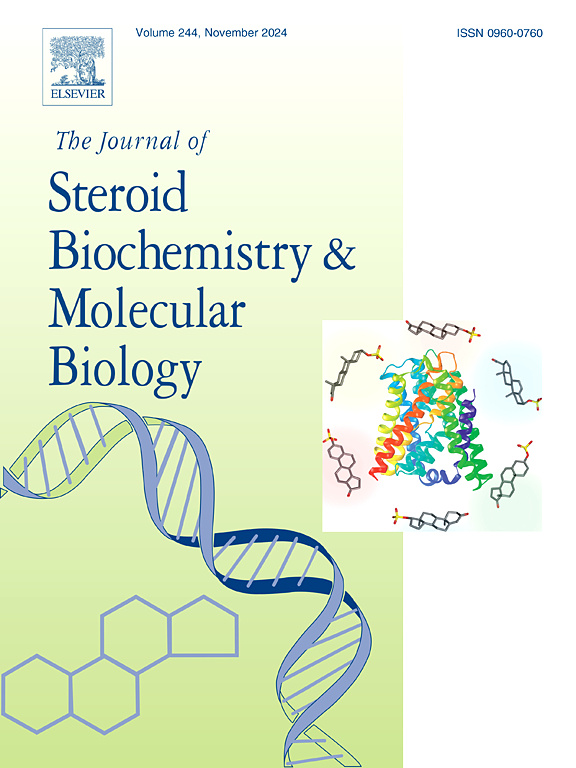胆固醇合成酶NSDHL致病错义突变的综合研究:低温和化学伴侣拯救选择突变体的低蛋白表达
IF 2.7
2区 生物学
Q3 BIOCHEMISTRY & MOLECULAR BIOLOGY
Journal of Steroid Biochemistry and Molecular Biology
Pub Date : 2025-04-11
DOI:10.1016/j.jsbmb.2025.106758
引用次数: 0
摘要
胆固醇对人类生命至关重要。22 种胆固醇合成酶中的任何一种受到干扰,都会导致毁灭性的发育疾病。每种酶都受到转录和翻译后的严格调控,在为细胞提供胆固醇方面发挥着关键作用。我们研究了胆固醇合成酶 NSDHL(NAD(P) Dependent Steroid Dehydrogenase-Like)中的 13 个错义突变和 1 个缺失突变,已知这些突变可导致 X 连锁发育疾病 CHILD(先天性半身不遂伴鱼鳞状红斑和肢体缺陷)综合征和 CK 综合征。人们对这些错义突变对 NSDHL 的稳定性和功能的影响知之甚少。在这里,我们发现所有突变体的蛋白质表达水平都很低,但有些突变体可以通过较低的温度(30°C vs. 37°C)和/或化学伴侣甘油来挽救。此外,NSDHL 蛋白的最佳表达需要热休克蛋白 70 和 90,这表明 NSDHL 中的疾病突变可能会干扰这种相互作用,也许是在翻译过程中导致蛋白质合成降低。我们的发现表明,这些致病突变会降低 NSDHL 蛋白的表达,但有些突变会对较低的温度和/或化学伴侣甘油产生反应,这有助于为 CHILD 和 CK 综合征的未来治疗提供依据。本文章由计算机程序翻译,如有差异,请以英文原文为准。
Comprehensive survey of disease-causing missense mutations of the cholesterol synthesis enzyme NSDHL: Low temperature and a chemical chaperone rescue low protein expression of select mutants
Cholesterol is essential to human life. Perturbations to any of the 22 cholesterol synthesis enzymes can lead to devastating developmental diseases. Each enzyme is exquisitely regulated both transcriptionally and post-translationally, playing a critical role in providing cholesterol to cells. We examined 13 missense mutations and one deletion mutation in the cholesterol synthesis enzyme NSDHL (NAD(P) Dependent Steroid Dehydrogenase-Like), known to cause the X-linked developmental disorders CHILD (congenital hemidysplasia with ichthyosiform erythroderma and limb defects) syndrome and CK syndrome. Little is known about the effect of these missense mutations on the stability and function of NSDHL. Here we show that protein expression levels were low for all mutants, but some could be rescued by a lower temperature (30°C vs. 37°C) and/or the chemical chaperone glycerol. Additionally, heat shock proteins 70 and 90 are needed for optimal NSDHL protein expression suggesting that disease mutations in NSDHL may interfere with this interaction, perhaps during translation resulting in lower protein synthesis. Our findings that these disease-causing mutations reduce NSDHL protein expression, but some respond to lower temperature and/or the chemical chaperone glycerol, can help inform future treatments for CHILD and CK syndrome.
求助全文
通过发布文献求助,成功后即可免费获取论文全文。
去求助
来源期刊
CiteScore
8.60
自引率
2.40%
发文量
113
审稿时长
46 days
期刊介绍:
The Journal of Steroid Biochemistry and Molecular Biology is devoted to new experimental and theoretical developments in areas related to steroids including vitamin D, lipids and their metabolomics. The Journal publishes a variety of contributions, including original articles, general and focused reviews, and rapid communications (brief articles of particular interest and clear novelty). Selected cutting-edge topics will be addressed in Special Issues managed by Guest Editors. Special Issues will contain both commissioned reviews and original research papers to provide comprehensive coverage of specific topics, and all submissions will undergo rigorous peer-review prior to publication.

 求助内容:
求助内容: 应助结果提醒方式:
应助结果提醒方式:


